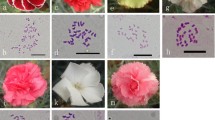Summary
Bilateral sexual tetraploidization was achieved by intercrossing diploid Phureja × haploid Tuberosum hybrids. Both parents contribute gametes with the somatic number of chromosomes (diplogynoids and diplandroids). More than 100 tetraploid progeny appeared in nine 2x−2x families. The tetraploids are generally more vigorous and significantly outyield their diploid ‘full-sibs’. The superiority of the tetraploids is interpreted on the basis of the mode of diplandroid (2n pollen) formation by first meiotic division restitution (FDR). Heterozygosis, epistasis and genetic diversity, if present in the parental diploid genotype, are largely maintained in the 2n gametes formed by FDR. and syngamy brings about more opportunities for heterotic responses in conjunction with polyploidization. Differences in tuber yield among tetraploid clones within families were found to be statistically significant (P <0.05). Thus, unlike somatic chromosome doubling, which can merely increase chromosome numbers, or somatic hybridization, which could in addition bring about heterosis, sexual polyploidization is also associated with genetic variability. The degree of inbreeding and the genotypic structure in the population of newly arisen tetraploids is discussed. The relationship among asexual reproduction, preservation of favorable nonadditive genetic effects by FDR. restoration of sexuality, and polyploidization is explored. The possible evolutionary significance of these factors is emphasized.
Similar content being viewed by others
References
Bingham, E. T., 1969. Experimental polyploid evolution in Medicago sativa. Genetics 61: Suppl. No. 2/Part 2, page 4.
Busbice T. H. & C. P. Wilsie, 1966. Inbreeding depression and heterosis in autotetraploids with application to Medicago sativa L. Euphytica 15: 52–67.
Cotterman, C. W., 1940. A calculus for statistic-genetics. Unpublished thesis. Ohio State University.
Crow J. F. & J. Kimura, 1970. An introduction to population genetics theory. Harper and Row Publishers, New York, Evanston and London.
De Wet J. M. J. & J. R. Harlan, 1970. Apomixis, polyploidy and speciation in Dichanthium. Evolution 24: 270–277.
Hanneman R. E. & S. J. Peloquin, 1967. Crossability of 24-chromosome potato hybrids with 48-chromosome cultivars. Eur. Potato J. 10: 62–72.
Hanneman R. E. & S. J. Peloquin, 1968. Ploidy levels of progeny from diploid-tetraploid crosses in the potato. Amer. Potato J. 45: 255–261.
Kempthorne O., 1957. An introduction to genetic statistics. John Wiley and Sons, Inc., New York.
Kidane-Mariam H. M. & S. J. Peloquin, 1972. Method of diplandroid formation and yield of progeny from reciprocal (4x−2x) crosses. Amer. Potato J. 49: 363–364.
Kidane-Mariam H. M. & S. J. Peloquin, 1974. Effect of direction of hybridization (4x×2x or 2x×4x) on yield in cultivated potatoes. Amer. Potato J. 51: 330–336.
Marks G. E., 1966. The origin and significance of intraspecific polyploidy: Experimental evidence from Solanum chacoense. Evolution 20: 552–557.
Mendiburu A. O. & S. J. Peloquin, 1970. Synthesis of tetraploid potatoes by interdiploid matings. Amer. Potato J. 47: 357.
Mendiburu A. O. & S. J. Peloquin, 1971. High yielding tetraploids from 4x−2x and 2x−2x matings. Amer. Potato J. 48: 300–301.
Mok D. W. & S. J. Peloquin, 1975. Three mechanisms of 2n pollen formation in diploid potatoes. Can. J. Genet. Cytol. 17: 217–225.
Peloquin S. J. & A. O. Mendiburu, 1972. Sexual polyploidization in relation to breeding and evolution. Amer. Potato J. 49: 363.
Rowe P. R., 1967. Performance of diploid and vegetatively doubled clones of Phureja-haploid Tuberosum hybrids. Amer. Potato J. 44: 195–203.
Steel R. G. D. & J. H. Torrie, 1960. Principles and procedures of statistics. McGraw-Hill Book Company, Inc., New York, Toronto, London.
Wang Hungshu, S. J. Peloquin & A. O. Mendiburu, 1971. Cytology of 2n pollen formation in two Phureja-haploid Tuberosum hybrids. Amer. Potato J. 48: 301.
Author information
Authors and Affiliations
Rights and permissions
About this article
Cite this article
Mendiburu, A.O., Peloquin, S.J. Bilateral sexual polyploidization in potatoes. Euphytica 26, 573–583 (1977). https://doi.org/10.1007/BF00021683
Received:
Issue Date:
DOI: https://doi.org/10.1007/BF00021683



